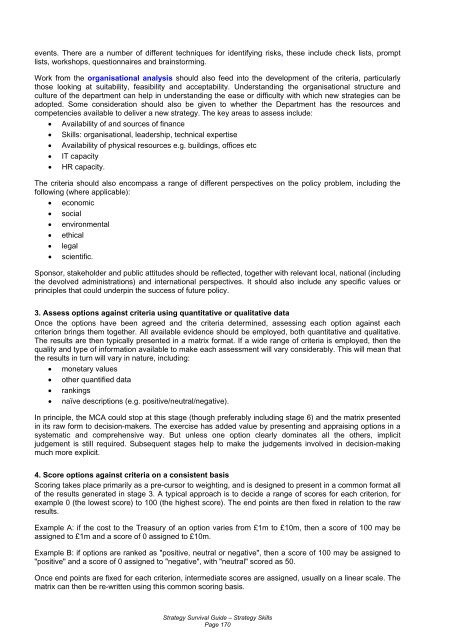Strategy Survival Guide
Strategy Survival Guide
Strategy Survival Guide
Create successful ePaper yourself
Turn your PDF publications into a flip-book with our unique Google optimized e-Paper software.
events. There are a number of different techniques for identifying risks, these include check lists, prompt<br />
lists, workshops, questionnaires and brainstorming.<br />
Work from the organisational analysis should also feed into the development of the criteria, particularly<br />
those looking at suitability, feasibility and acceptability. Understanding the organisational structure and<br />
culture of the department can help in understanding the ease or difficulty with which new strategies can be<br />
adopted. Some consideration should also be given to whether the Department has the resources and<br />
competencies available to deliver a new strategy. The key areas to assess include:<br />
• Availability of and sources of finance<br />
• Skills: organisational, leadership, technical expertise<br />
• Availability of physical resources e.g. buildings, offices etc<br />
• IT capacity<br />
• HR capacity.<br />
The criteria should also encompass a range of different perspectives on the policy problem, including the<br />
following (where applicable):<br />
• economic<br />
• social<br />
• environmental<br />
• ethical<br />
• legal<br />
• scientific.<br />
Sponsor, stakeholder and public attitudes should be reflected, together with relevant local, national (including<br />
the devolved administrations) and international perspectives. It should also include any specific values or<br />
principles that could underpin the success of future policy.<br />
3. Assess options against criteria using quantitative or qualitative data<br />
Once the options have been agreed and the criteria determined, assessing each option against each<br />
criterion brings them together. All available evidence should be employed, both quantitative and qualitative.<br />
The results are then typically presented in a matrix format. If a wide range of criteria is employed, then the<br />
quality and type of information available to make each assessment will vary considerably. This will mean that<br />
the results in turn will vary in nature, including:<br />
• monetary values<br />
• other quantified data<br />
• rankings<br />
• naïve descriptions (e.g. positive/neutral/negative).<br />
In principle, the MCA could stop at this stage (though preferably including stage 6) and the matrix presented<br />
in its raw form to decision-makers. The exercise has added value by presenting and appraising options in a<br />
systematic and comprehensive way. But unless one option clearly dominates all the others, implicit<br />
judgement is still required. Subsequent stages help to make the judgements involved in decision-making<br />
much more explicit.<br />
4. Score options against criteria on a consistent basis<br />
Scoring takes place primarily as a pre-cursor to weighting, and is designed to present in a common format all<br />
of the results generated in stage 3. A typical approach is to decide a range of scores for each criterion, for<br />
example 0 (the lowest score) to 100 (the highest score). The end points are then fixed in relation to the raw<br />
results.<br />
Example A: if the cost to the Treasury of an option varies from £1m to £10m, then a score of 100 may be<br />
assigned to £1m and a score of 0 assigned to £10m.<br />
Example B: if options are ranked as "positive, neutral or negative", then a score of 100 may be assigned to<br />
"positive" and a score of 0 assigned to "negative", with "neutral" scored as 50.<br />
Once end points are fixed for each criterion, intermediate scores are assigned, usually on a linear scale. The<br />
matrix can then be re-written using this common scoring basis.<br />
<strong>Strategy</strong> <strong>Survival</strong> <strong>Guide</strong> – <strong>Strategy</strong> Skills<br />
Page 170
















